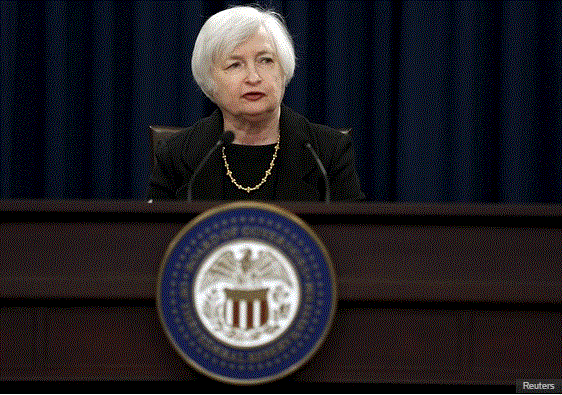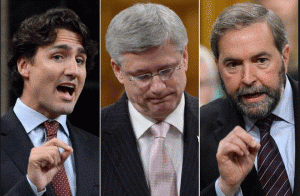FED LEAVES RATES UNCHANGED!
The Federal Open Market Committee (FOMC) surprised FX traders (or at least ½ of them) when they left interest rates unchanged, at today’s highly anticipated meeting.
The kicker is that the statement is more doveish than what was released on July 29th due to references of deflation pressures stemming from global and economic financial developments. In addition, the FOMC’s may not be as convinced of the sustainability of the US recovery due to “developments abroad” and the prospect of a more rapid slowing of Chinese economic growth than anticipated.
The result is ‘no-result”. Traders everywhere will continue to watch data, listen to Fed speakers and attempt to anticipate when the Fed will pull the trigger and raise rates. October is a live” date but it is unlikely the Fed would move make such a major move, without a press conference. And at the moment, there isn’t one scheduled.
Janet Yellen explains why the FOMC left rates unchanged. Pic-Reuters
Loonie weighed down by major risks
The Canadian dollar has joined the balance of the G-10 currencies and rallied following the FOMC decision to leave rates unchanged. But that doesn’t mean that the Loonie is out of the frying pan, it just means the heat has been turned down a tad.
The Canadian dollar is vulnerable to three key risks:
- Oil Prices. A major factor behind the Canadian dollar’s weakness has been the massive decline in oil prices. A debate is raging as to whether or not the bottom has been seen. Yesterday’s surprise drawdown in US crude supplies as reported by the energy Information Agency (EIA) sparked a 4% rally in WTI prices. However, it may have merely been a short squeeze in markets with less liquidity than normal, due to today’s FOMC meeting. FOMC Chairwoman, Janet Yellen, in today’s press conference alluded to some concerns that China’s economy could slow further than anticipated. Who would sop up the extra oil supplies from Iran and a unified Libya?
- BoC rate cut risk. If the US economy isn’t growing fast enough to support a mere ¼ point rate increase from basically 0%, where will Canada’s growth come from? The Bank of Canada (BoC) governor has repeatedly stated that domestic growth will come from an increase in exports. The rate cut in January was due, in part to help shore up falling exports. Will they do it again? When the BoC cut rates another ¼ point in July, it was due in part, to a widening output gap, The output gap is defined as the difference between the actual output of an economy and its potential output and the Canadian output gap is getting worse not better. That keeps the door open for rate cut number 3 in 2015.
- Canadian Election: For many Canadians, at this point in time, the federal election is merely a series of annoying ads proclaiming one guy isn’t ready, another guy, is an opportunist, and the third guy is bad for workers. But that is today. In another 33 days Canadians can be wakening up to a new government and a new government led by the New Democrat Party (NDP), a political party not know for fiscal responsibility. They would also wake up to a Loonie flying south faster than a Snowbird in January.
Three cards, none named Monte Pic: Source Ottawa Citizen
Managing your exposure
USDCAD has been locked within a 1.2950-1.3350 trading band since July 15 the when the Bank of Canada cut interest rates for the second time this year. It hasn’t looked back. The post FOMC plunge from 1.3180 to 1.3073 was quick and short lived. USDCAD is now back to where it was before the news. The speed of the reversal is an indication that the market place continues to have a bullish USDCAD bias, but within the context of the existing trading band.
The next month won’t be a whole lot different from the previous two months except that liquidity should improve as summer holidays are over. The current range is likely to remain intact although US dollar sellers should be cautious.







